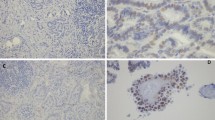Abstract
The aims of this study is to evaluate the presence of estrogen receptors alpha (ERα) in thyroid lesions and to assess the practicality of this test in view of numerous disagreements on the subject. Immunohistochemical stains were performed for ERα, for the evaluation of immunoreactivity in 296 pathological thyroid tissue samples. We evaluated the intensity of the nuclear and cytoplasmatic staining and the spread of the stain over the sample. Thirty cases of the breast cancer served as a control group. None of the histological thyroid samples showed immunoreactivity for ERα. No difference was found between the various lesions in regard to this absence. The ERα rate of expression in the breast cancer samples was 60%. The ERα is undetectable in the histological samples of benign and malignant thyroid lesions. Further investigation is necessary in the laboratory immunohistochemical workup in order to exclude a possibility of non-specific staining.


Similar content being viewed by others
References
Miki H, Oshimi K, Mrimoto T, Monden Y (1990) Sex hormone receptors in human thyroid tissues. Cancer 66:1759–1762
Henderson BE, Ross RK, Pike MC, Casagrande JT (1982) Endogenous hormones as a major factor in human cancer. Cancer Res 42:3232–3239
Samaan NA, Maheshwari YK, Nader S et al (1983) Impact of therapy for differentiated carcinoma of the thyroid. J Clin Endocrinol Metab 56:1136–1138
Lewy-Trenda I (2002) Estrogen and progesterone receptors in neoplastic and non neoplastic thyroid lesions. Pol J Pathol 53:67–72
Greene GL, Nolan C, Engler JP, Jensen EV (1980) Monoclonal antibodies to human estrogen receptor. Proc Natl Acad Sci USA 77(9):5115–5119
Garancis JC, Miller LS, Tomita JT, Tieu TM, Clowry LJ Jr (1983) Immunoperoxidase localization of estrogen receptors in human breast carcinoma. Cancer Detect Prev 6(1–2):235–239
Gilbert C (1997) Major human cancers are preventable: physiological stimuli induce a dopamine-thyroid-immune efficient mechanism. Eur J Cancer Prev 6(3):269–276
Sonoo H, Kurebayashi J (2001) Endocrine therapy for advanced or recurrent breast cancer. Gan To Kagaku Ryoho 28(7):909–916
Mosselman S, Polman J, Dijkema R (1996) ERβ: Identification and characterization of a novel human estrogen receptor. FEBS Lett 392(1):49–53
van Hoeven KH, Menendez-Botet CJ, Strong EW, Huvos AG (1993) Estrogen and progesterone receptor content in human thyroid disease. Am J Clin Pathol 99(2):175–181
Hiasa Y, Nishioka H, Kitahori Y et al (1993) Immunohistochemical analysis of estrogen receptors in 313 paraffin section cases of human thyroid tissue. Oncology 50(2):132–136
Yane K, Kitahori Y, Konishi N et al (1994) Expression of estrogen receptor in human thyroid neoplasm. Cancer Lett 84:59–66
Giani C, Campani D, De Negri F et al (1993) Interference of thyroperoxidase on immuno-cytochemical determination of steroid receptors in thyroid tissue. J Endocrinol Invest 16(1):37–43
Candanedo-Gonzalez FA, Gamboa-Dominguez A (2007) Postmenopause is associated with recurrence of differentiated papillary thyroid carcinoma. Med Hypotheses 69(1):209–213
Diaz NM, Mazoujian G, Wick MR (1991) Estrogen-receptor protein in thyroid neoplasms. An Immunohistochemical analysis of papillary carcinoma, follicular carcinoma, and follicular adenoma. Arch Pathol Lab Med 115(12):1203–1207
Katoh AK, Stemmler N, Specht S, D’Amico F (1997) Immunoperoxidase staining for estrogen and progesterone receptors in archival formalin fixed, paraffin embedded breast carcinomas after microwave antigen retrieval. Biotech Histochem 72(6):291–298
Stoss F, Spona J (1987) Steroid hormone receptors in struma. Wien Klin Wochenschr 99(13):460–461
Hampl R, Nĕmec J, Heresová J, Kimlová I, Stárka L (1985) Estrogen receptors in human goitrous and neoplastic thyroid. Endocrinol Exp 19(4):227–230
Kawabata W, Suzuki T, Moriya T, Fujimori K et al (2003) Estrogen receptors (a and b) and 17b-hydroxysteroid dehydrogenase type 1 and 2 in thyroid disorders: possible in situ estrogen synthesis and action. Mod Pathol 16:437–444
Zeng Q, Chen G, Vlantis A, Tse G, van Hasselt C (2008) The contributions of oestrogen receptor isoforms to the development of papillary and anaplastic thyroid carcinomas. J Pathol 214(4):425–433
Cho MA, Lee MK, Nam KH, Chung WY et al (2007) Expression and role of estrogen receptor alpha and beta in medullary thyroid carcinoma: different roles in cancer growth and apoptosis. J Endocrinol 195(2):255–263
Ceresini G, Morganti S, Graiani V et al (2006) Estrogen receptors (ER)- B but not ER-A is present in thyroid vessels: immunohistochemical evaluation in multinodular goiter and papillary thyroid carcinoma. Thyroid 6:1215–1220
Bléchet C, Lecomte P, De Calan L et al (2007) Expression of sex steroid hormone receptors in C cell hyperplasia and medullary thyroid carcinoma. Virchows Arch 450(4):433–439
Kurzon RM, Sternberger LA (1978) Estrogen receptor immunocytochemistry. J Histochem Cytochem 26(10):803–808
Pertschuk LP, Gaetjens E, Carter AC et al (1979) An improved histochemical method for detection of estrogen receptors in mammary cancer. Comparison with biochemical assay. Am J Clin Pathol 71(5):504–508
Goulding H, Pinder S, Cannon P et al (1995) A new immunohistochemical antibody for the assessment of estrogen receptor status on routine formalin-fixed tissue samples. Hum Pathol 26(3):291–294
Harvey JM, Clark GM, Osborne CK, Allred DC (1999) Estrogen receptor status by immunohistochemistry is superior to the ligand-binding assay for predicting response to adjuvant endocrine therapy in breast cancer. J Clin Oncol 17(5):1474–1481
Rhodes A, Jasani B, Barnes DM et al (2000) Reliability of immunohistochemical demonstration of oestrogen receptors in routine practice: interlaboratory variance in the sensitivity of detection and evaluation of scoring systems. J Clin Pathol 53(2):125–130
Huang Z, Zhu W, Szekeres G, Xia H (2005) Development of new rabbit monoclonal antibody to estrogen receptor: immunohistochemical assessment on formalin-fixed, paraffin-embedded tissue sections. Appl Immunohistochem Mol Morphol 13(1):91–95
Author information
Authors and Affiliations
Corresponding author
Rights and permissions
About this article
Cite this article
Vaiman, M., Olevson, Y., Sandbank, J. et al. Are estrogen receptors alpha detectable in normal and abnormal thyroid tissue?. Eur Arch Otorhinolaryngol 267, 1753–1757 (2010). https://doi.org/10.1007/s00405-010-1269-0
Received:
Accepted:
Published:
Issue Date:
DOI: https://doi.org/10.1007/s00405-010-1269-0




